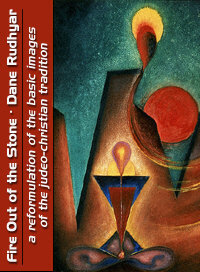 |
| Home | Bio | Art | Music | Literature | Civilization & Culture | Philosophy of Wholeness | Theosophy & Spirituality | Astrology |

FIRE OUT OF THE STONE A Reformulation of the Basic Images of the Judeo-Christian Tradition by Dane Rudhyar, 1962 1. Not to Repeat, But to Renew 2. The Essence and the Substance 3. To Become "More-Than-Man" 4. The Fatherhood of God 5. At the Center is Soul 6. Creation and Evolution 7. Crisis and Sin 8. The Coming-Together of God and Man 9. Christ-Love: The Covenant with Individual 10. The Life of Mediation and its Paradox • Page 1 • Page 2 • Page 3 • Page 4 • Page 5 • Page 6
: : :
This title was first published by Sevire, 1963. Cover for the online edition copyright © 2008 by Michael R. Meyer. : : : : : :
"Thy God is a cosumming fire." Duet. 4:25 "He shall baptize you with the Holy Spirit and with fire." Matthew 3:11 "I am come to send fire on the earth." Luke 12:49
: : :
|

10. THE LIFE OF MEDIATION AND ITS PARADOX - page 4"When man is as the woman and the woman as the man, there you will find me," Gnostic Saying of Jesus If the first Beatitude refers to the surrender of all that represents traditional wealth, the second refers to the surrender of all emotional-personal attachment, for what we mourn is what we have been emotionally attached to. The third Beatitude indicates the need of surrendering all forms of aggressiveness — an important factor in the society to which Jesus addressed himself, for two currents then divided the Jewish people, one advocating political violence, the other love. The fourth Beatitude refers to the need to abandon all prejudices, that is, literally, all judgments of value based on traditions and customs antedating any actual experience in the life of the individual which are related to such judgments. The old "righteousness" was established on values which the coming of Christ made obsolete. The Christ-oriented individual inevitably and paradoxically "hungers and thirsts after righteousness" — just as he is a "beggar in spirit" (first Beatitude) — because he must have seen all ancient Images of spirit, righteousness and ritual purity fade from his consciousness. He is totally empty, naked as a newborn baby. Now something new will fill this baby's body — air; that is, pneuma, breath, spirit in the new sense of the term, the Spirit of Truth. The second set of four Beatitudes establishes positively what must be the main fourfold character of the way of life and relatedness which the disciple of Christ, the future Son of God, must exemplify. 1. Mercy is the basic quality of all relationships expressing the new status of the individual who has actually become the field of relatedness between God and human nature; it is compassion, all-inclusive and redeeming love-charity. It can only be attained by the "beggars in spirit". The first and fifth Beatitudes are thus linked in that paradox that only through the utter surrender of all wealth can the all-inclusive abundance of the plenitude of relationship linking God to man be experienced and radiated as mercy or Christ-love; for it is this surrender alone which can open to man the "Kingdom of heaven" (first Beatitude). 2. Purity of heart signifies a dynamic life-sustaining type of motivation which both accepts and gives out, as the heart receives and releases with new vigor the blood of the whole organism. Such a kind of motivation cannot be a fact where the heart is attached to this or that particular object of desire or enjoyment. Thus only those who have "mourned" the loss of all such attachments can truly be "pure in heart". They "shall see God" (6th Beatitude) because to "see God" is to become aware of the ineffable wholeness of all there is, to have come face to face with the absolute Beauty that is all-encompassing Harmony. How could one, after such an experience, be exclusively attached to any one particular ever-changing fragment of this universal Wonder which, from whatsoever point of view it is seen, remains always wonderfull? 3. Peace-generating activity (i.e. the activity of "peace-makers") can only proceed from a consciousness in which the opposing forces of existence (such as good-and-bad, high-and-low, etc.) are harmonized in dynamic interplay. Such a consciousness is the true spiritual inheritance of any man who has understood the awesome power of the Fatherhood of God in Whom all opposites are contained as in a vast cosmic "dance". Such an understanding should assuredly make one "meek", humble! This very humility, this childlike awe before the majesty of the Father, is the very condition which allows a man "to inherit the earth"; for paradoxically, pride always generates opposition and leads to a fall. Likewise only the man who is willing spontaneously and joyously to serve whomever or whatever he loves or admires can be trusted to be a leader. Such a quality in relationship makes of a man a true "child of God" and proves his capacity to manage "the earth", that is, all facets of this dualistic existence of ours, filled with everlasting conflicts. 4. The uncompromising allegiance to the Truth at the center of our being, even to the point of enduring all persecutions, comes only to the individual who has found himself totally empty of the values of the past and thus hungers and thirsts for the Annunciation from the new Spirit, the new "righteousness" (i.e. the new rites of activity, the new creative manifestation of Truth). Such an individual, like Mary, will be "filled", and to him will be given the power of the Creative Order, which is the Kingdom of Heaven. There remains only the ninth Beatitude which brings the general principles thus stated to a focusing conclusion. Every universal spiritual Truth must be brought to a particular focus of activity here and now; it must address itself to a need of the place and the time — or else it is not "spiritual"! I repeat that if one can say that spirit is universal and operating everywhere, it is because it is focused at every point of space simultaneously. But, wherever spirit is seen in operation, it is never found expressed in terms of "generalities" but always in a precise formulation directed toward the solution of a particular problem. However, "particular" is here to be understood as referring to a particular group situation; in any case, to one specific whole, collective or personal though it be. If then Jesus makes such pronouncements as the first eight Beatitudes — the four basic steps to the spiritual life, the life of mediation — it is because he sees before him men and women who can become his "disciples" and whose potentially uncompromising character (not perfectly so actually, as Peter's future behavior will at least twice reveal!) will make them subject to revilement and persecution. The universal principles of the way of Christ potentially open to every man are thus focused in a statement of actual fact-in-the-making; that is, of what is immediately ahead for those of Jesus' hearers who are ready to tread this way of Christ. The comparison between the apostles-to-be who will be persecuted and the "prophets which were before you" is significant in that it establishes a functional filiation between these prophets of the Old Order and the spiritual sons of Christ. The evolution of the soul, which the whole Bible symbolically narrates, is a continuous process, and the Fatherhood of God impregnates and pervades one level after another of this evolution. But with the coming of Christ a basically new phase begins. Where before there was "overshadowing", now there is "Marriage". Man needs no longer to become only a screen upon which the likeness and image of God-Elohim can be projected under relatively rare and specially prepared conditions. Man needs not only to reflect the essential relatedness that potentially links him to his Creator; he can be this relatedness. He can be the Field in which the relationship, God to human nature, is effected in act. He can be container of that relationship. He can thus fulfill the destiny of Man, which is to be the sacred vessel — the Chalice — within which the Divine and the natural interpenetrate in an alchemical rite of transsubstantiation and thereby of redemption of the past. The past is redeemed as the present is transsubstantiated in the light of a future in which past, present and future are realized in the essential and structural unity of a whole cycle of universal manifestation, an Eon.  Home | About | Calendar | Ephemeris Charts | Art Gallery | Library | Resources Shop | Rudhyar Archival Project | Help Web design and all data, text and graphics appearing on this site are protected by US and International Copyright and are not to be reproduced, distributed, circulated, offered for sale, or given away, in any form, by any means, electronic or conventional. See Notices for full copyright statement and conditions of use. Web design copyright © 2000-2004 by Michael R. Meyer. All Rights Reserved. |